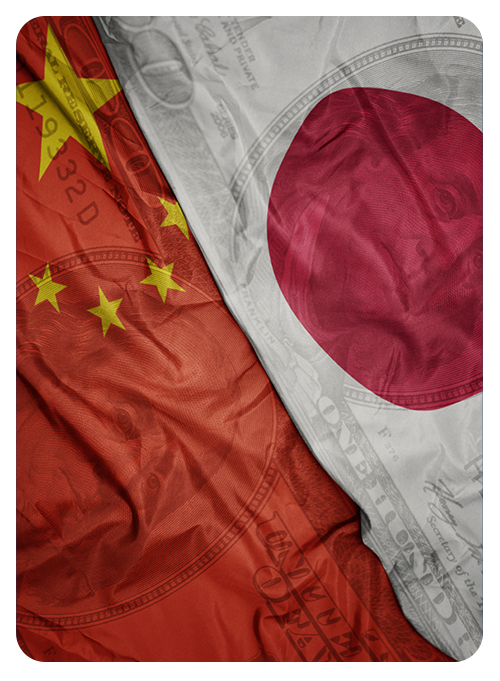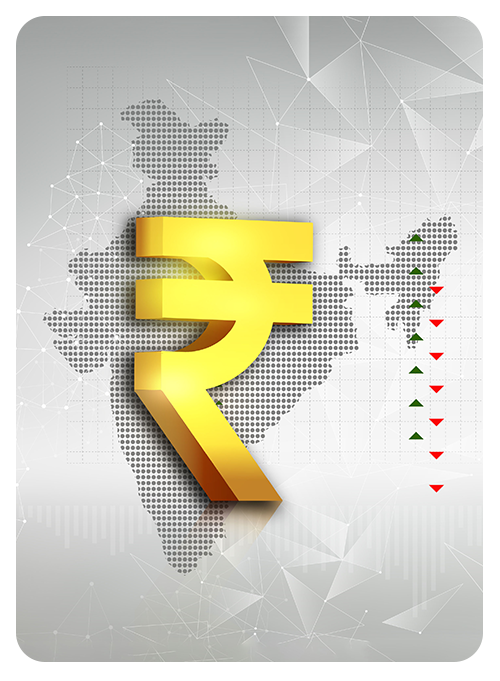Finsphere
High Stakes Ahead:
Navigating Markets Through Caution, Tariffs, and Opportunity

Dear Clients and Stakeholders,
Indian equity markets extended its recent streak of monthly gains for a third consecutive month, notching up 1.3% in May. The month also marked the conclusion of Q4FY25 corporate earnings season, which turned out to be mixed bag. Revenue growth remained in the mid-single digits, volume growth was in low single digit, reflecting subdued business momentum. Global outlook continues to remain clouded owing to rising protectionism through tariffs while the tone of management commentaries was tentative/ cautious. However, RBI’s surprising outsized front-loaded pro-growth monetary roll out on 6th of June’25 is likely to be a game changer for India in context of present global scenario. Given this backdrop, investors need to remain selective and prioritize high quality stocks that may become available at attractive valuations.
Trade policy continues to dominate global headlines. Uncertainty escalated throughout May, with the US and China’s retaliatory tariffs reaching a staggering 145%, nearly resulting in a full-blown trade embargo. However, a temporary breakthrough was reached on May 12th when both nations agreed to a 90 day pause. As part of the agreement, the US lowered tariff on Chinese imports to 30% from 145% while China reduced its tariffs on US goods to 10% from 125%.
The breakthrough in negotiations boosted investor sentiment with S&P 500 climbing 6.15% in May, reaching 5,912, while the Nasdaq surged 9.04% to 21,341. The Dow Jones Industrial Average posted a strong 3.94% gain, closing at 42,270, and broader markets reflected similar enthusiasm, with the Russell 2000 advancing 5.2% to 2,066.
However, any respite was short lived as the trade storm further intensified in June. China — which supplies over 90% of the world’s rare earth elements — refused to rollback its export ban on rare earths, introduced on 4th April in response to ‘Liberation Day’ tariffs. Meanwhile, the US announced 50% tariffs on the EU from June 1st before eventually agreeing to extend the deadline to July 9th while simultaneously hiking tariffs on steel and aluminium from 25% to 50% from June 4th. These actions triggered backlash from US’s trading partners who continued to negotiate trade agreements with Mexico and the EU signaling readiness to retaliate if a balanced trade agreements could not be reached. With only the UK having finalized a bilateral trade agreement, and the 90-day tariff pause set to expire on July 8th, the coming weeks are likely to be pivotal in shaping the global trade landscape.
United States
Tariffs Continue to Dictate the Narrative.
The US economy contracted in Q1CY25 by 0.2% — its first quarterly decline in three years — largely due to a 42.6% surge in imports, as businesses front-loaded purchases ahead of expected tariff hikes. Consequently, the US trade deficit hit a record $140.5 billion in March. Despite these headwinds, inflation eased to 2.3% in April, the lowest since February 2021, while producer prices fell by 0.5%. The core PCE price index — the Fed’s preferred inflation gauge — rose 2.5% year-on-year, its lowest since March 2021.
The continued uncertainty surrounding the impact of tariffs on inflation and economic growth, however, prompted the Fed to keep the fund rate unchanged at 4.25%-4.50% for the third consecutive time.
Consumer behavior showed signs of caution, with retail sales rising just 0.1% month-on-month in April. Industrial production remained flat, weighed down by sluggish mining and manufacturing output. Elevated mortgages weighed in on the housing market with prices of single-family homes declining 0.1% in March 2025.

Building permits declining 4.7% month-on-month in April while hosing starts saw a modest 1.6% month-on-month improvement after declining 10.1% in March. However, new home sales bucked the trend and surged 10.9% month-on-month as builder incentives helped alleviate affordability challenges faced in the resale market.
With trade negotiations with key partners still ongoing and the announcement of the new tax bill which the Congressional Budget Office (CBO) estimates would add nearly USD 4 trillion to the country’s existing national debt of USD 36 trillion, the scrutiny of the country’s long term fiscal sustainability continues intensify.

Eurozone & UK
Gradual Stabilization Amid Trade Escalations.
In the Eurozone, headline inflation moderated to 1.9% in May, well below the ECB’s target of 2% while core inflation eased to 2.3%, a three-year low. Industrial production surged 2.6% month-on-month in March, though retail trade edged lower by 0.1%. The current account surplus widened to EUR 60.1 billion, as exports surged in anticipation of US tariffs.
The UK saw a 25-bps rate cut by the Bank of England in May, bringing the policy rate to 4.25%, in response to easing of inflation. However, headline inflation, as anticipated, rose to 3.5% in April due to earlier spike in energy prices. Retail sales surprised with a 1.2% month-on-month increase, while industrial production contracted 0.7%, underscoring mixed economic signals.
As the July 9th deadline looms, the path forward for EU hinges on both EU and US reaching a balance trade deal to avoid any economic disruption. While negotiations continue, the sharp escalations from US underscores the fragility of the trade negotiations. Meanwhile, UK’s ability to quickly negotiate a bilateral trade agreement has erased uncertainty and boosted confidence.
Asia
Trade Negotiations and Domestic Demand in Focus.
Japan’s economy contracted by an annualized 0.7% in Q1 2025 — its first in a year — at a point when the country is locked in trade negotiations with its major trading partner, the US. The domestic economy continued to be resilient with retail sales growing for the 37th consecutive month at 3.3% year-on-year, supported rising wages and a stable unemployment rate of 2.5%.
However, the decline in exports to US has remained a cause for concerns even as total exports rose for the seventh consecutive month at 2%. Industrial production posted a modest 0.2% month-on-month growth in March. Meanwhile, the headline inflation held steady at 3.6% in April, while producer prices rose 4% year-on-year suggesting pricing pressures continued to remain sticky.
China’s central bank, meanwhile, cut its benchmark 1-year and 5-year LPRs by 10 bps to 3.0% and 3.5% respectively. The rate cuts follow a broader monetary easing push aimed at supporting growth amid faltering domestic consumption and heightened tensions with the US.

The continued policy push to boost demand aided the 6.1% growth in industrial production in April while retail sales grew at 5.1%, albeit below expectations of 5.5% growth.The labour market continued to show improvement with unemployment falling to 5.1%, its lowest since December 2024. Meanwhile, the trade surplus surged to USD 96.18 billion in April, aided by 8.1% year-on-year rise in exports and a modest 0.8% growth in imports.
The two of the largest economies in Asia have been left facing significant challenges. With both countries being largely export driven and trade negotiations proving difficult, particularly in the case of China, continued domestic demand would likely play a critical role in helping weather global shocks.

India
India’s Economic Pulse: Resilient Growth Amid Global Turbulence.
India continues to remain the fastest growing economy major economy despite GDP growth slowing down to a four year low of 6.5% in FY25. However, in Q4FY25, India witnessed robust GDP growth of 7.4% - the highest in the last four quarters - driven by softer food and energy prices, accommodative monetary policy, and sustained domestic demand. Inflation eased to 3.16% in April, well below the RBI’s 4% target, reinforcing the case for future rate cuts. Meanwhile, wholesale inflation slowed to 0.85%, largely driven by an 18.26% plunge in vegetable prices. On the labour front, unemployment for April remained steady at 5.1% according to the first ever monthly Periodic Labour Force Survey (PLFS).
Despite India’s trade deficit widening to USD 26.42 billion, driven by a 19.1% rise in imports outpacing 9.03% export growth and a modest industrial output growth (2.7% YoY), the macroeconomic picture remains largely encouraging. The rollout of new tax regime is likely to boost domestic consumption along with RBI’s supportive liquidity stance, domestic demand is expected to cushion global shocks.
Conclusion
As global markets remain gripped by heightened trade tensions, India stands out as a relative beacon of stability. However, the broader global landscape remains fragile. With US-China-EU relations under strain and the deadline for resumption of ‘liberation day’ tariffs fast approaching, volatility is likely to persist.
At Chola Securities, we remain steadfast in our commitment to helping you navigate these complexities with clarity and foresight. As always, we aim to align your investments with evolving opportunities while ensuring resilience against emerging headwinds.
We sincerely thank you—our valued clients and investors—for your continued confidence and partnership. Together, we look forward to embracing the challenges and opportunities of the months ahead, ensuring sustained growth and success.
Warm Regards,
Mr. Senthilkumar Naidu
Chief Business Officer, CSec
